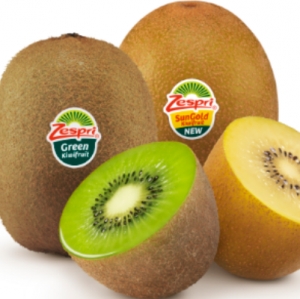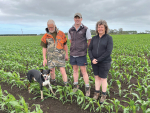Zespri will allocate 1130ha of licences for the more Psa-tolerant gold kiwifruit cultivar Gold3 to its growers in 2013, as the next step in the Psa recovery pathway – 288ha more than planned.
This includes 688ha of new gold licences for Green growers and new developments, as well as 442ha of Gold One-for-One licences, where Hort16A growers can transfer to Gold3.
Zespri chairman Peter McBride says the significant over-subscription shows the confidence the kiwifruit industry has in the recently-licensed gold cultivar, its performance to date in the Psa environment and growers increasingly looking to diversify their orchard portfolios.
"Following this licensing round, around 60% of New Zealand kiwifruit growers will grow at least one Zespri licensed variety, showing the continued transformation of the industry from its historical reliance on Hayward to increasing diversification of cultivars at orchard level," McBride says.
"We think it is important to allow growers the opportunity to diversify into Gold, but we also need to take the total supply picture into account. Our intention has been to build Gold supply towards 60 million trays and this year's allocation almost gets us there.
"This means we will probably need to reduce next year's fixed bid area and change the allocation rules so growers who have not had the opportunity to participate in the fixed bid process are preferred over other bidders for next year's licensing round.
"In the meantime, Zespri will also modify the grafting restrictions and allow growers to delay grafting this year if they prefer, so we have a more phased increase in future volumes. Growers who elect to defer grafting until after 2014 will also be able to defer their licence payments for an additional year."
Zespri senior management will review their medium- and long-term planning in light of this year's allocation and will present this work to the board to determine future allocation plans.
McBride said the board and executive expect to be in a position to discuss the situation with growers through the August grower meetings.
This licence allocation builds on last year's release of 2352ha, bringing the total amount of Gold3 licensed hectares in New Zealand to 3972. The Gold3 recovery pathway aims to rebuild the Gold category and grow Gold volumes beyond pre-Psa levels.
"Zespri is building up Gold volumes in response to the medium- and long-term demand we see from emerging markets," McBride says.
Gold3 is marketed internationally under the name SunGold. It was selected from the extensive Zespri and Plant & Food Research new variety programme for its qualities of high orchard yields, handling characteristics, storage and positive appeal to consumers determined through in-market sensory work over consecutive seasons.
Subsequent to its commercial release, Gold3 has, to date, shown a greater level of tolerance to Psa than the original Zespri Gold variety, Hort16A. This level of Psa tolerance combined with Gold3's commercial qualities has made it the cornerstone of the recovery pathway from Psa and this year
Gold3 comprises around 20% of Zespri's total Gold volume.
"This spring is a critical period for us to understand how well Gold3 can produce in a Psa environment and while it is clear growing in the Psa environment will be challenging, the demand for Gold3 licences this year is testimony to an emerging confidence by growers in the variety," McBride says.
There are currently no Psa-resistant kiwifruit varieties and the industry continues to rely on proactive orchard management and scientific innovation to find new ways of growing productively in a Psa environment.
"It's important to note that it is only thanks to the unified structure of the kiwifruit industry and the resilience of its growers that we've been able to make this pace of progress," Mr McBride said.



















